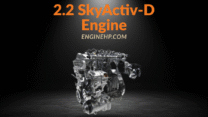
Mazda Engines: 1.5 SkyActiv-D Engine Hp, Reliability, and Performance
Introduction
The Mazda 1.5 SkyActiv D engine is small but savvy. It gave diesels of the present the latest look, with tiny displacement, low compression, and high efficiency. This page provides the most concise and easy-to-read description about the 1.5 SkyActiv-D’s specifications as well as how it behaves on the road, common issues, reliability expectations and tips for maintenance (such”best oil” and “best oil” and diagnostic tools). This guide is designed to provide quick answers and action in real time no matter if you’re looking for a second-hand Mazda2, Mazda3, or CX-3 or you would like to know more about the engine prior to having it serviced.
Mazda announced it was going to announce in the year 2014 that the next Mazda2 will feature a brand new engine. The engine was later utilized for CX-3 and Mazda3. Mazda3 as well as the CX-3 models.
Engine Overview
- What it is: 1.5 SkyActiv-D Mazda’s small displacement turbocharged diesel motor (inline-4 DOHC 16-valve) which was designed to meet strict standards for pollution while still preserving the torque at low end of the diesel. Fourth-generation Mazda2 (Demio) is the very first model to feature it, and eventually appeared within Mazda3 (Axela) and CX-3. Mazda3 (Axela) as well as the CX-3 in a few countries.
- Production years & cars using it: Mazda2/Demio Mazda3/Axela and CX-3 were all in Europe as well as Japan from 2014 until 2018.
- Engine type summary: Certain models comprise an inline turbocharged diesel engine that has common rail direct injection, variable-geometry turbo and two-stage turbo technology. The engine has low compression to comply with the environmental requirements. The engine is renowned for its combination of torque that is useful and performance in small cars.
Technical Specifications
Clean standards that are indexable for quick scanning. These values indicate how the factory evaluated the major models (there are slight distinctions between the manual and the automatic, and also between those of the Mazda3 as well as CX-3 variants).
| Specification | Details |
| Manufacturer | Mazda |
| Production years | 2014–2019 |
| Cylinder block material | Aluminum |
| Cylinder head material | Aluminum |
| Fuel type | Diesel |
| Fuel system | Direct fuel injection |
| Configuration | Inline |
| Number of cylinders | 4 |
| Valves per cylinder | 4 |
| Valvetrain layout | DOHC |
| Bore, mm | 76 |
| Stroke, mm | 82.5 |
| Displacement, cc | 1,497 cc (91.35 cu in) |
| Type of internal combustion engine | Four-stroke, turbocharged |
| Compression Ratio | 14.0:1 |
| Power, hp | 103 hp (77 kW) @ 3,500–4,500 rpm |
| Torque, lb ft | 162–199 lb ft (220–270 Nm) @ 1,800–2,500 rpm |
| Engine weight | – |
| Firing order | 1–3–4–2 |
| Engine oil capacity, liter | 5.1 – service change5.8 – dry0.4 – filter |
| Engine oil weight | 0W-30 |
| Oil change interval, mile | 12,000 (20,000 km)/12 months |
| Cars with this engine | Mazda CX-3, Mazda2 |
MZR/L3-VE 2.3L Engine
Performance and Driving Feel
The 1.5 SkyActiv-D looks like a tiny diesel engine designed for daily driving. It is a great engine that has plenty of power straight off the line and stays calm when cruising and runs well on gas when it is handled properly. The engine produces its torque in the early hours, usually around 1,400 rpm. You can easily pass other vehicles in the city, and then start climbing hills without having to rev up. In low RPMs you’ll feel a powerful bass that will make the automobile “feel punchy.” At highway speeds, where the turbo and insulation help keep the noise and vibration to a minimum the car is more refined. When used in a mix of applications in the real-world, the combined fuel efficiency for the Mazda3 or Mazda2 equipped with this engine can be less than 5.5 L/100 km. This is a great value for a small car. The actual efficiency will depend on how you drive, how much traffic and the location.
This engine has been designed to provide greater torque and fuel efficiency rather than just pure power. This means that everyday drivers consider that the 1.5 SkyActiv-D engine is more responsive or rev-happy. The SkyActiv-D “responds quickly” at low speeds and doesn’t feel stressed regardless of how full it is with bags or passengers. For long stretches of highway it’s comfortable and quiet with a steady speed however, you may hear more of a diesel engine sound as you speed up. In comparison to larger diesels, the turbo speeds up rapidly. Its 1.5 diesel’s gears (6-speed manuals or autos) maintain the engine in the right place to allow for passing. The engine isn’t suited for those who want thrilling rapid acceleration However, it’s a fantastic alternative for those who drive to work and would like to reduce their expenses.
Common Problems & Weak Points
These are the places that most people prefer to go to. Tone: helpful – symptoms as well as causes and easy solutions.
Oil consumption / burning
- Cause: The old piston rings, the valve stem seals, or even driving too fast could cause this. Some owners have reported that the amount of oil they use increases as mileage gets higher.
- Signs:The level of the oil drops between services and there is a blue-ish smoke when you accelerate or the warning light for oil appears when the oil level is low.
- Solution: For older vehicles examine the level of oil every 1000 miles. If the oil level is higher than what the manufacturer claims is normal, you should switch into the diesel recommended oil, and clean the valve rings and piston seals. Removing the filter and oil frequently reduces the chance of. (See “Best Oil” below).
Idle vibration or rough idle
- Cause: Chain stresses or strains the tensioner. This happens more often for bigger SkyActiv diesels, however it’s good to be on the lookout for smaller models as well.
- Signs: It can be a sign that the engine is cold, a metallic sound when the car is idle, or an engine check light in extreme situations.
- Solution: Identifying problems early by examining them and replacing the chain or tensioner promptly will make the engine last for longer. Do not ignore the noises that your chain continues to occur and ask a mechanic to examine it.
Sensor faults or oil leaks
- Cause: The reason could be due to carbon build-up in the intake valves, issues with the EGR/DPF system as well as an issue with the injection system. If the injectors as well as the EGR system are dirty, the diesels may shake even more.
- Signs: An obvious shaking of the engine when it is idle and a rough run until it gets warm.
- Solution: Clean the injectors and EGR channel. You can use premium diesel fuel, and adhere to the instructions for regeneration of DPF. Shops can help clean or balance the injectors.
Sensor faults or oil leaks
- Cause: The reason is that valves, sensors and gaskets are affected by the effects of age and heat cycles. There are many engines that leak in the oil pan, as well as gaskets on the valve cover.
- Signs: Oil patches underneath the car, instruments that aren’t working properly as well as warning signals.
- Solution: Search for leaks, fix sensors that aren’t functioning immediately, and keep service records in order to spot patterns earlier.
Note: The reports vary based on the market conditions and how drivers drive. Many owners don’t have any issues for long periods of time if they are keeping up with their maintenance. Catalogue of Cars
Reliability and Lifespan
The owner’s reports indicate that the 1.5 SkyActiv-D could last between 200,000 and 300,000 miles or more, if well-maintained, particularly when the type of oil is changed, the intervals between changes are maintained and timely repairs are carried out. The quality of the oil’s lubrication, the service intervals, quality of fuel and whether the vehicle frequently takes long journeys (which is beneficial to the DPF) is among the primary elements that influence the reliability. Car owners frequently say that the engine is affordable and easy to use on a daily basis however, they also state that the maintenance for diesel engines (DPF cleaning of EGR injector service) is required for a long-lasting engine.
Maintenance Tips
Long-form, practical checklist (good for buyers & owners):
Every 10,000 to 15,000 kilometers and, as the manual for owners says for your particular market, you should change the filter and oil. If you go on frequent short trips then you must do it more often. Make sure you use a low-SAPS diesel oil that meets Mazda’s viscosity specifications (the owner’s manual provides the exact specifications that is typically 5W-30 or 0W-30 diesel oil). Make sure you use a high-quality diesel and maintain the cleanliness of your fuel system to lessen the load on the injectors as well as the DPF. If you typically travel for short distances, you should plan to take longer trips every occasionally to allow your DPF to regenerate. Find leaks of oil within the turbo intake and pay attention to the speed at which the oil is utilized. If you hear any noises coming from the tensioner or chain take it off and replace the parts that are involved in timing. Make sure you use the correct coolant and replace it regularly to ensure your car stays cool and last for longer. Mazda Owner’s Manual+1
DIY quick checks (safe, simple):
- Make sure to check the valve cover and the oil pan each month for leaks of oil.
- Every week, test the level of oil in older vehicles.
- If your car’s engine is lagging or your exhaust is smelling strange This is a sign to look into.
- Inspect the turbo hoses to find holes and then clean your air filters regularly.
Best Oil for Mazda 1.5 SkyActiv-D
It is recommended to select an oil with low-sAPS that is in line with Mazda’s specifications (see the owner’s manual for your area). Mazda suggests synthetic 0W-30 or 5W-30 oils that comply with the ACEA C2/C3 requirements for diesels that fall in this category. To ensure that the emissions system will be compatible with your vehicle make sure you use the exact Mazda/ILSAC/API grade that are listed within the guide.
Recommended OBD2 Scanners for Diagnostics
- Entry-level: Bluetooth OBD2 adapter that comes with Torque/OBD applications that are good for reading codes.
- Mid-range: Handheld reader that shows live data as well as freeze frames.
- Pro-level: A two-way scan tool that is able to read diesel-specific DPF/EGR/DPF regeneration instructions.
- A tip for buying: Select tools that are able to detect live data PIDs of diesel or MAZDA to aid in fixing problems right.
Engine Alternatives
1.5 SkyActiv-D vs 1.5 SkyActiv-G (petrol): Pick the diesel to get better efficiency in terms of fuel consumption and torque. Select the SkyActiv-G model for lower maintenance, more quiet operation, and more efficient cold-starting in areas with moderate temperatures.
1.5 SkyActiv-D vs 2.2 SkyActiv-D: 2.2 SkyActiv-D 2.2 offers more torque as well as towing power, however it is more expensive and may require more maintenance. 1.5 is the best choice for daily use and saves money.
Commercial/Monetization Subtopics
- Best oil : Please suggest the top synthetic 0W-30 and 5W-30 with low-SAPS diesel oils that comply with ACEA C2/C3 as well as Mazda standards. Include comparisons of the oils quality, viscosity and cost per litre.
- Replacement parts & common-service items: The parts that must be replaced as well as items that require servicing often: When purchasing an old car ensure that you have a list of the smallest items such as filters (oil or fuel), air) as well as turbo inlet gaskets, valve cover hoses as well as EGR gaskets.
- Engine rebuild & repair cost guide: Median costs for repairs such as cleansing or replacing the injectors rebuilding turbos, and timing components, as being a rough estimation of the costs of rebuilding an engine as compared to the cost of purchasing an used vehicle (based on the local market prices). Make a list of the things to consider when making a decision on whether to repair the issue or buy a new one.
FAQs
Is the Mazda 1.5 SkyActiv-D reliable?
It’s generally safe when you change the oil on a regular basis and keep an eye on your diesel engine. A lot of owners report that their cars have been able to travel 200,000 – 300,000 miles or more.
How long does the 1.5 SkyActiv-D last?
If you take good care of it, it’s likely to last between 200,000 and 300,000 miles or more. The time that it will last depends on how you travel, how often you service it, and the amount of oil you put in.
Does it use a timing belt or chain?
SkyActiv-D engines are equipped with an automatic timing chain. The life expectancy of the chain and tensioner is dependent on the way they’re maintained. They should be inspected when they sound.
What cars use the 1.5 SkyActiv-D?
The most popular models are the Mazda2 (Demio), Mazda3 (Axela) as well as CX-3 from specific models (launched on the market in 2014). There is a range of availability depending on where you live.
What oil should I use?
If you are selling on the market, make sure to use the grades of oil listed within the Mazda owner’s manual. This usually means an oil with a low-sAPS synthetic 0W-30/5W-30 which meets the requirements of the Mazda/API/ACEA.
Conclusion
If you’re looking for a small vehicle that can get decent gas mileage but doesn’t lose important power, then this Mazda 1.5 SkyActiv-D is a good alternative. It is ideal for those who commute to work, or with families that are small and want lower running costs as well as an impressive pull with moderate acceleration. It’s a practical and economical engine in the used market so long as it receives regular oil adjustments in addition to EGR and injector tests and focuses on how the DPF operates. If you have one, maintain a service diary and track the levels of oil. If you’re considering buying one, make sure you request maintenance records as well as a test of the injectors and compression.










Leave a Reply